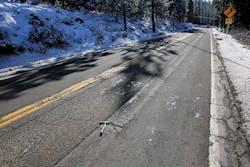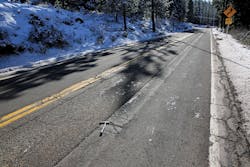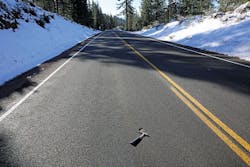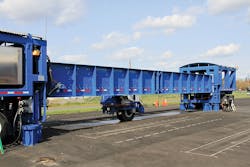Gaining full motion
The first full-depth reclamation (FDR) pilot project on a California Department of Transportation (Caltrans) highway was undertaken in 2001 on S.R. 20 in Colusa County. A number of other pilot projects followed on state, county and city highways.
Early performance on these pilot projects was generally excellent, but a few issues were observed which prompted the awarding of a Caltrans research project to the Pavement Research Center at the University of California, Davis. Until 2001, most research on FDR had been conducted in southern Africa and Australia, where pavements typically have thin chip seal surfacings and where recycling is predominantly focused on the old, but quality aggregate- or cement-treated base materials. In California, the pavements considered for FDR typically have multiple asphalt layers that have been placed over the decades on top of very thin marginal aggregate base courses. Given the weaker underlying structures, many of these pavements have bad fatigue cracking, which quickly reflects through a new overlay. The research therefore needed to consider design and construction issues specific to recycling thick asphalt layers.
Early performance of the FDR pilot projects in California was generally excellent, but a few issues were observed which prompted the awarding of a Caltrans research project to the Pavement Research Center at U of C, Davis.
Guiding it through
The research has been undertaken in multiple phases. Early studies focused on recycling using foamed asphalt together with cement as a stabilizer. Research involved observations of construction practices on state and county highways, the regular monitoring of performance on these pilot sections (visual and falling weight deflectometer), as well as a detailed laboratory study to understand the stabilization mechanisms and to develop mix design procedures. The results of this early research were used to prepare an interim Caltrans guideline covering design and construction and a chapter on FDR in the Caltrans’ Maintenance Technical Advisory Guide (MTAG). Caltrans, FDR contractors and the Pavement Research Center staff worked together on preparing specifications for FDR projects.
Later research has continued to investigate foamed asphalt and cement as well as investigating recycling using no stabilizer (that is, the old asphalt layers are essentially recycled back into a new aggregate base without the addition of any additives), using asphalt emulsion instead of foamed asphalt and using only cement. This research has included monitoring construction and performance on existing and new pilot projects, continued laboratory testing and an accelerated pavement testing study on a purpose-built test track at the University of California, Davis. Accelerated pavement testing was carried out on all four stabilization strategies mentioned above, under both dry and wet conditions (i.e., water was injected into the recycled base layer) to assess moisture sensitivity. Life-cycle cost analyses and environmental life-cycle assessments also were carried out as part of the study.
Outputs from this later research are currently being analyzed for the preparation of a revised guideline covering the selection of the most appropriate stabilization strategy for a given set of variables, pavement and mix design procedures, recommended construction procedures and mechanistic-empirical performance models that can be used to optimize the pavement and rehabilitation design, specifically in terms of the thickness of the new asphalt surfacing. Guidance on life-cycle cost analyses and sustainability studies also will be provided. The Caltrans MTAG chapter on FDR will be updated. Specifications for each recycling strategy (i.e., no stabilizer, foamed asphalt with cement, asphalt emulsion with or without active filler and cement only) also have been prepared by Caltrans, in conjunction with industry and academia, using experience learned from pilot projects and the research study and are included in the new 2015 Caltrans specifications (Section 30).
The latest research has included monitoring construction and performance on existing and new pilot projects, continued laboratory testing and an accelerated pavement testing study on a test track.
What you need to know
Key lessons learned from the research, which have been factored into guidelines and specifications, include but are not limited to:
• All FDR projects should be designed—a “one-size-fits-all” approach should not be followed. The main reason for this is that the causes of distress in the existing pavement will vary from project to project and need to be accounted for in the design to prevent premature failure of the new pavement. Project design should include understanding variability along the length of the road being investigated;
• Like all other pavements, drainage is critical. Poor drainage will lead to significantly reduced pavement life;
• FDR with no stabilizer should be limited to lower traffic volume roads. Although some residual cementing of the old asphalt binder may occur over time, it will have a limited stabilization effect. Accelerated load testing under wet conditions indicated that these pavements would be particularly susceptible to early problems under poor drainage conditions;
• If foamed asphalt is selected as the stabilizer, the “foamability” of the binder needs to be checked. Anti-foam agents are often used during transport of crude oil and refined binders, which can affect dispersion of the asphalt through the recycled material. Small quantities of either cement or lime (choice will depend on the chemistry of the aggregates that are being recycled) must always be added to enhance the asphalt stabilization process and provide early strength for early opening to traffic;
• The FDR layer should not be over-designed—too high a strength can be problematic in that very stiff layers are susceptible to cracking. Very stiff/strongly cemented materials also will be difficult to recycle again at the end of the pavement’s design life;
• Stabilization reactions are affected by ambient and material temperatures and these need to be taken into consideration when planning FDR construction;
• Performance of stabilized materials is affected by the fines content (percent passing the No. 200 sieve) and care should be taken to determine mix designs (asphalt, cement and other active filler content) on representative material samples;
• Mix design should include tests on both dry and soaked specimens to understand any moisture sensitivity issues. The soaked strength should be used as the design criterion;
• Old pavements are typically highly variable in terms of asphalt and underlying layer thickness and moisture content. Although designs based on thorough preconstruction investigations will limit problems encountered during construction, it is important that contractors have experienced technicians on-site who constantly monitor the recycling process and instruct the equipment operators to make appropriate adjustments to stabilizer and water contents to accommodate for this variability;
• Most FDR projects are awarded to primary contractors who subcontract the recycling work to recycling contractors. The primary contractor needs to work with the recycling contractor to understand that compacting and finishing stabilized FDR layers is different to aggregate bases and that changes in equipment, timing and approach may be necessary to achieve a satisfactory result;
• Recyclers are very efficient milling and mixing machines and the number of passes should be minimized to prevent excessive breakdown of the aggregates. Depending on layer thicknesses, satisfactory asphalt stabilization can typically be achieved in a single recycler pass. Cement stabilization typically requires two passes: the first to pulverize and mix the cement, the second to add and mix water and to further blend the cement with the existing materials;
• Although they are efficient, the recyclers used for FDR are designed for optimal vertical mixing rather than transverse mixing. Consequently the spreading of cement or lime ahead of the recycling train needs to be accurate and consistent to prevent accumulations that can result in localized areas of excessively high strength, which in turn can lead to early localized cracking. Care also should be taken to restrict any traffic from driving on the spread stabilizer and to prevent hoses that connect the recycler, and the water and asphalt tankers (on asphalt stabilization projects) from redistributing the cement or lime;
• Mixing and compaction water must be fed through the recycler and not sprayed from a separate tanker behind the recycler. This ensures consistent mixing throughout the layer;
• The weight of the primary compactor (typically a padfoot roller) must be matched to the recycling depth. Too light a roller will result in poor compaction at the bottom of the recycled layer, which in turn can lead to early rutting as the layer consolidates under traffic. Too heavy a roller can lead to crushing of aggregates and/or pumping of fines from silty-clay subgrades into the recycled layer;
• The primary roller must follow closely behind the recycler to ensure that the stabilized layer is compacted immediately before stabilization reactions set up and before the added compaction water evaporates. Primary compaction should continue until the padfoot roller does not leave any impressions and the target density has been achieved or exceeded. Final shaping and final compaction with smooth drum and tire rollers can then be completed;
• A good tight surface must be the end result after final compaction. This tight surface must be maintained either by spraying dilute asphalt emulsion after compaction and/or by regular light water sprays while the base is trafficked to ensure that a good surface still exists when the asphalt surfacing is applied; and
• Good quality control/quality assurance and sound engineering practice is always important for FDR projects to succeed.
FDR is a cost-effective and sustainable approach to pavement rehabilitation. Good performance on highways that have been rehabilitated using FDR, research findings and the experience gained by agency staff and contractors all suggest that FDR should no longer be considered as experimental, but instead as a standard rehabilitation practice option and used where appropriate. Sound engineering practice should always be used on their design and during construction.



